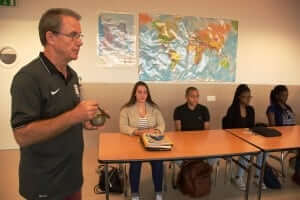Bora Rancic has worked as a teacher and administrator in both international and national schools around the world including in the UK, Barbados, Solomon Islands, Bahrain, Brunei, Thailand and Malawi. He currently works with grades 11 and 12 students and their teachers as the IB Diploma Coordinator at Luanda International School, Angola—an IB World School.

As an administrator, I wonder how to influence not only my specific context but also our ever more global, interdependent world. How can we learn to track these changes and stay calm? The average human attention span continues to decrease (in a recent study reduced from 26 seconds to 16 seconds) while we continue to have more than 50,000 thoughts a day! School-wide conversations on the tools we need to live well inspire my work in bringing mindfulness to our campus. And I’m not alone—I am supported by colleagues within the school, by the International Baccalaureate’s emphasis on student well-being as well as on academic achievement, and by colleagues in other member schools of the Association of International Schools in Africa (AISA).

Monday to Friday, I start my school day with a one-minute practice with grade 11, one of our focus groups for this year. On Wednesdays, I’m joined by Nicola Warwick, my friend and fellow Year-Long colleague, for Mindful Schools curriculum work during the students’ Wellbeing block. Each lunchtime finds me back for a 10 minute practice with a small group of teachers and grade 11 students who opt in, a great boost for the afternoon ahead. While twenty percent of the faculty has taken the Mindfulness Fundamentals, embedding mindfulness in the school goes slowly. This is a process I’m learning, and being patient with the process IS the curriculum. All I need to do is to make room for it.
In his talk, Pico Iyer concludes that home is not where you sleep but where you stand. Before, I don’t think I would have been able to absorb that idea. Now, though, as an itinerant educator, my mindfulness practice is slowly letting me build a home within.
Bora is currently enrolled in our Year-Long Certification Program. You can reach Bora to ask more about mindfulness at Luanda International School and/or within AISA, at brancic@lisluanda.com, and tweets @borarancic.
